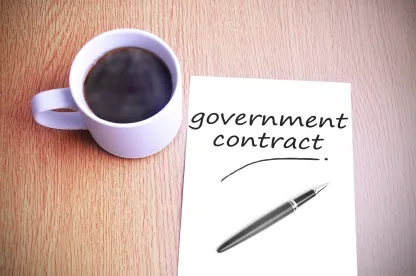On September 9, 2021, President Biden signed an Executive Order (EO) to implement COVID safety protocols for Federal service contractors. While the EO did not identify specific safety protocols, it did direct a Federal task force (the “Safer Federal Workforce Task Force,” created by Executive Order in January 2021) to issue COVID-19-related workplace safety guidance for prime contractors and subcontractors in the near future. Specifically, the Task Force is charged with issuing contractor guidance by September 24, 2021, including definitions of relevant terms, specific workplace safety protocols, and applicable exceptions.
While the announcement of the new EO was somewhat overshadowed by the President’s concurrent vaccine mandate for all Federal workers, it is of great importance to Federal contractors and subcontractors. The EO is broadly worded; and while it does NOT apply to all contractors, it will impose new compliance obligations upon many.
At the same time that President Biden announced the EO, he also announced that OSHA will be developing an emergency standard that would require employers with 100+ employees to mandate that employees be vaccinated or submit to weekly testing. Like the EO, much remains unknown about the rule.
This Client Alert answers many of the questions regarding the EO. Obviously, this is a “live event,” and much still is not known about how the EO will be implemented. The Sheppard Mullin GovCon Team will continue to watch the roll out of the new rule closely, and update this Q&A over the coming weeks.
What Does The Rule Require?
Nothing yet. But soon the Task Force will issue a number of COVID safety measures, to which prime contractors and subcontractors must adhere. We do not yet know what these safety measures will require, but we can guess, based upon the current Federal measures promulgated by the Task Force, they will cover mask wearing, physical distancing, sick leave policies, work at home policies, testing requirements, exposure protocols, meetings/events rules, and perhaps vaccinations (which, per a recent executive order, now will be required for most Federal employees). The Task Force guidance must be reviewed and approved by OMB before it goes into effect.
All that being said in annoucing the EO, President Biden seemed to tip his hand on whether the Task Force will require vaccinations as part of its guidance. During his public remarks, the President made the following statement:
-
I will sign an executive order that will now require all executive branch Federal employees to be vaccinated — all. And I’ve signed another executive order that will require Federal contractors to do the same.
-
If you want to work with the Federal government and do business with us, get vaccinated. If you want to do business with the Federal government, vaccinate your workforce.
The EO does not require Federal contractors to vaccinate their employees. But if the Task Force makes such a recommendation, that will change. For the moment, while all the headlines state that Federal contractors must vaccinate their workforce, this conclusion is a bit premature – if only until September 24th.
To What Contracts Does The Rule Apply?
The EO applies to contracts and contract-like instruments, which, according to the Department of Labor, means any “agreement between two or more parties creating obligations that are enforceable or otherwise recognizable at law.” The DOL definition (which is expressly incorporated into the EO) includes, but is not limited to, any “mutually binding legal relationship obligating one party to furnish services (including construction) and another party to pay for them.” This would cover direct awarded competitive contracts, sole source/ limited source contracts, Government-wide acquisition contracts, other multiple award contracts (including the GSA and VA Schedules), and task orders issued under MACs.
The forthcoming clause will find its way into all “new contracts” including renewals, extensions, and option exercises. The clause will not, however, be included in contracts or subcontractors below the Simplified Acquisition Threshold, currently set at $250,000. Nor will the clause (yet) apply to grants.
In short, even with the SAT exception, contractors and subcontracts should think of the scope of the EO as very broad. The proposed definition includes almost all contracts and subcontracts at any tier, whether negotiated or advertised, including procurement actions, lease agreements, cooperative agreements, provider agreements, intergovernmental service agreements, service agreements, licenses, permits, or any other type of agreement, regardless of nomenclature, type, or particular form, and whether entered into verbally or in writing.
What Products/Services Are Covered?
Importantly, the EO covers only services; it does not cover products. Indeed, it seems the EO does not even reach all services, but rather only services covered by the SCA. It is worth noting, however, that the language of the EO is not a model of clarity in this regard. Here is specifically what the EO says the new clause will cover:
-
Procurement contract/CLI for services, construction, or a leasehold interest in real property;
-
Contract/CLI covered by the Service Contract Act;
-
Contract/CLI for concessions, including any concessions contract excluded by DOL regulations; or
-
Contract/CLI entered into with the Federal Government in connection with Federal property or lands and related to offering services for Federal employees, their dependents, or the general public.
While (i) mentions “services” without an SCA limitation, we’d argue that reference is intended to cover services in the real property context. Otherwise, why would we need subsection (ii)? If (i) was meant to cover all services, (ii) would not be necessary. But we concede it’s not completely clear.
It’s also useful to note what the EO expressly does not cover. The EO does not apply to:
-
Grants;
-
Contracts/CLIs with Indian Tribes;
-
Contracts or subcontracts whose value is equal to or less than the simplified acquisition threshold;
-
Employees who perform work outside the United States or its outlying areas; or
-
Subcontracts solely for the provision of products.
The inclusion of (v) is telling in that it reminds us that the forthcoming clause (1) is intended to flow down to subcontractors and (2) is intended to apply to mixed products/service subcontracts.
The clause does not provide insight into if/how it will apply to technology companies providing software-as-a-service, platform-as-a-service, and other license-based cloud offerings to the Federal Government. The question could come down to whether the contractor identifies its offerings as products or services. For example, companies offering software-as-a-service may find themselves pulled into compliance with the forthcoming rule, while companies offering software as a product may avoid the rule’s application.
A similar question arises with regard to contractors offering non-labor services, such as web hosting, telecommunications services, satellite bandwidth, and the like. If these services are sold as a service, then presumably the new clause will cover the personnel supporting those services. On the other hand, where those services are sold as a product, the new clause may not apply.
Again, the EO seems to indicate that these types of non-labor services contracts would only be covered by the EO if the contract(s) at issue themselves already are covered by the SCA, even if the companies providing these non-labor services to the Federal Government consider them to be services (assuming our interpretation of subsection (i) as applying only to contracts for real property).
Interestingly, when President Biden issued the $15/hour Minimum Wage Executive Order, the White House used similarly broad language. When the DOL issued the draft Rule, however, the applicability was narrowed to contracts the principal purpose of which is to furnish services in the United States through the use of service employees. This Executive Order directly incorporated the definition of a contract from the Minimum Wage Executive Order, and therefore we would not be surprised to see a similar narrowing of scope during the rulemaking process for this EO.
Does The Rule Cover Indirect Employees?
The forthcoming clause will cover anyone “working on or in connection with” a Federal contract or subcontract. The “in connection with” language is interesting. Presumably, it is meant to cover employees beyond direct billers. While the EO does not define the term, a recent DOL regulation using the same language is instructive. DOL considers a worker performing “in connection with” a covered contract to be “any worker who is performing work activities that are necessary to the performance of a covered contract but who is not directly engaged in performing the specific services called for by the contract itself.” For example, according to DOL, a payroll clerk who processes the paychecks of a direct bill employee – though not performing directly on the contract – is performing “in connection with” the contract. Conversely, again according to DOL, a janitor who is hired to clean the bathrooms of the contractor’s building or a landscaper who is hired to cut the lawn outside the building, is not performing work necessary to the performance of the contract, and therefore, is not performing work “in connection with” such contract.
This obviously is a very broad interpretation of “in connection with.” By DOL’s definition, Finance, Accounting, and Contracts, all could fall within the scope of the forthcoming clause. Perhaps even HR personnel would be covered. This is a much broader formulation than we typically use when we consider who is supporting a Federal contract, and obviously significantly increases the reach of the internal controls/compliance program that will need to be developed to ensure compliance.
What If I Do Not Work On A Government Site?
It doesn’t matter. The rule is intended to keep contractors and subcontractors healthy in order to “promote economy and efficiency” in the procurement process. Thus, the forthcoming clause will apply to any workplace location in which an individual is working on or in connection with a Federal Government contract or contract-like instrument. The clause covers both Governed-site and Contractor-site employees. Notably, however, the clause will not cover employees performing work outside the U.S.
Does The Rule Flow Down To Subcontractors?
Yes. The forthcoming clause will flow down to subs at every tier, except “subcontracts solely for the provision of products.” Accordingly, we should expect to see the new clause added to the list of “mandatory flow downs” identified in FAR 52.212-5(e) and FAR 52.244-6. This means that, shortly, prime contractors will have to dust off their standard flow-down provisions, self-certifications, subcontracts, and vendor agreements to add a new provision.
How Will The Rule Be Implemented?
The EO will be implemented through a new FAR clause that will have to be incorporated into new solicitations and new contracts. (Remember, “new” contracts includes options, renewals, extensions, etc.) The FAR Council has until October 8, 2021 to provide policy direction to acquisition offices to hold us over until a formal rule is issued. This direction likely will encourage agencies to exercise their authority to issue FAR deviations to implement the EO until a proposed or interim rule is issued. As was the case with earlier COVID-related rules, we suspect GSA likely will be one of the first agencies to issue a deviation.
When Does The Rule Go Into Effect?
The Executive Order already is in effect, although, at the moment, it has no immediate practical implication on contractors. The first material date will be October 8, 2021, when the FAR Council will “take initial steps” to implement policy direction to acquisition offices.
What Should I Do Now?
As the issuance of the new clause is right around the corner, there are some useful steps contractors can take now to give themselves a step up once the new rule is issued. Here are a few ideas:
-
Gather and review your agreements with flow-down provisions (vendor agreements, subcontracts, etc.) since you will have to update those in the near future.
-
Begin identifying those employees who work “in connection with” your Federal contracts since they will be covered by any new internal controls you implement.
-
Take a look at the current guidelines issued by the Safer Federal Workforce Task Force as they will give you a good sense of what the new clause will require.
-
Evaluate whether your current offerings are products or services. Obviously, this will be an easy evaluation in many cases, but, as noted above, it will be a far more complicated question for some.
-
Keep your eyes open for prime contractors flowing down COVID 19-related clauses in advance of the issuance of the new official clause. The Task Force rules do not yet apply to contractors.
-
If you have not done so already, begin thinking about how you will implement a vaccination order. While there currently is no universal vaccine mandate in place, the President has strongly suggested there will be one for contractors soon. (And DOL is engaging in a parallel rulemaking that will require companies with 100 employees or more either to require vaccinations or test weekly, whether they are Federal contractors or not.)
-
Wear a mask, avoid large crowds, keep your distance, wash your hands, and get vaccinated.





 />i
/>i

